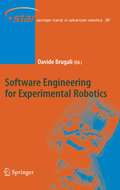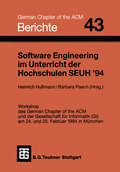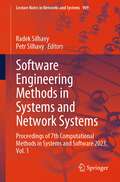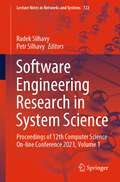- Table View
- List View
Software Engineering for Experimental Robotics (Springer Tracts in Advanced Robotics #30)
by Davide BrugaliThis book reports on the concepts and ideas discussed at the well attended ICRA2005 Workshop on "Principles and Practice of Software Development in Robotics", held in Barcelona, Spain, April 18 2005. It collects contributions that describe the state of the art in software development for the Robotics domain. It also reports a number of practical applications to real systems and discuss possible future developments.
Software Engineering for Manufacturing Systems: Methods and CASE tools (IFIP Advances in Information and Communication Technology)
by DennisJarvis AlfredStorrSoftware has become a decisive cost and time factor in regard to developing and establishing manufacturing systems and setting them into operation. In addition, software determines the availability, reliability as well as functionality of manufacturing units. Software Engineering for Manufacturing Systems considers the methods and procedures required to deal with problems in the software engineering of control technology for manufacturing systems. Significantly, the following topics are addressed: * definitions and requirements of software for control technology * system design, describing forms of control software * CASE tools for the generation of a code * configuration, adaption of standard software variants, and re-usability of software * and man-machine interface. It contains the selected proceedings of the International Conference on Software Engineering and Case Tools for Control Technology of Manufacturing Systems, sponsored by the IFIP and held in Germany, in March 1996.
Software Engineering for Robotics
The topics covered in this book range from modeling and programming languages and environments, via approaches for design and verification, to issues of ethics and regulation. In terms of techniques, there are results on model-based engineering, product lines, mission specification, component-based development, simulation, testing, and proof. Applications range from manufacturing to service robots, to autonomous vehicles, and even robots than evolve in the real world. A final chapter summarizes issues on ethics and regulation based on discussions from a panel of experts. The origin of this book is a two-day event, entitled RoboSoft, that took place in November 2019, in London. Organized with the generous support of the Royal Academy of Engineering and the University of York, UK, RoboSoft brought together more than 100 scientists, engineers and practitioners from all over the world, representing 70 international institutions. The intended readership includes researchers and practitioners with all levels of experience interested in working in the area of robotics, and software engineering more generally. The chapters are all self-contained, include explanations of the core concepts, and finish with a discussion of directions for further work.Chapters 'Towards Autonomous Robot Evolution', 'Composition, Separation of Roles and Model-Driven Approaches as Enabler of a Robotics Software Ecosystem' and 'Verifiable Autonomy and Responsible Robotics' are available open access under a Creative Commons Attribution 4.0 International License via link.springer.com.
Software Engineering im Scientific Computing: Beiträge eines Workshops in Hamburg 6.–8. Juni 1995
by Wolfgang MackensBei Entwicklern und Anwendern numerischer Software besteht dringender Bedarf an modernen und praxisnahen Konzepten der Informatik. Umgekehrt stellt die Informatik Werkzeuge zur Verfügung, die im wissenschaftlichen Rechnen nicht immer wahrgenommen werden. Das Ziel dieses Buches ist es, die gemeinsamen Probleme und Ziele des wissenschaftlichen Rechnens und der anwendungsorientierten Informatik für die jeweiligen Gruppen darzustellen, zur Verbesserung der Kommunikation zwischen den Gruppen beizutragen, sowie praktische Werkzeuge, Informatik-Methoden und Anforderungen des wissenschaftlichen Rechnens bekannt zu machen.
Software Engineering im Unterricht der Hochschulen SEUH ’92 und Studienführer Software Engineering (Berichte des German Chapter of the ACM)
by Jochen Ludewig Kurt SchneiderSoftware Engineering im Unterricht der Hochschulen SEUH ’93 (Berichte des German Chapter of the ACM)
by Jörg Raasch Thomas BasslerSoftware Engineering im Unterricht der Hochschulen SEUH ’94 (Berichte des German Chapter of the ACM)
by Heinrich Hussmann Barbara PaechSoftware Engineering im Unterricht der Hochschulen SEUH ’95: Workshop des German Chapter of the ACM und der Gesellschaft für Informatik (GI) am 23. und 24. Februar 1995 in Bremen (Berichte des German Chapter of the ACM)
by Andreas Spillner Ulrich BreymannSoftware Engineering in IoT, Big Data, Cloud and Mobile Computing (Studies in Computational Intelligence #930)
by Haengkon Kim Roger LeeThis edited book presents scientific results of the International Semi-Virtual Workshop on Software Engineering in IoT, Big data, Cloud and Mobile Computing (SE-ICBM 2020) which was held on October 15, 2020, at Soongsil University, Seoul, Korea. The aim of this workshop was to bring together researchers and scientists, businessmen and entrepreneurs, teachers, engineers, computer users, and students to discuss the numerous fields of computer science and to share their experiences and exchange new ideas and information in a meaningful way. Research results about all aspects (theory, applications and tools) of computer and information science, and to discuss the practical challenges encountered along the way and the solutions adopted to solve them. The workshop organizers selected the best papers from those papers accepted for presentation at the workshop. The papers were chosen based on review scores submitted by members of the program committee and underwent further rigorous rounds of review. From this second round of review, 17 of the conference’s most promising papers are then published in this Springer (SCI) book and not the conference proceedings. We impatiently await the important contributions that we know these authors will bring to the field of computer and information science.
Software Engineering in the Era of Cloud Computing (Computer Communications and Networks)
by Muthu Ramachandran Zaigham MahmoodThis book focuses on the development and implementation of cloud-based, complex software that allows parallelism, fast processing, and real-time connectivity. Software engineering (SE) is the design, development, testing, and implementation of software applications, and this discipline is as well developed as the practice is well established whereas the Cloud Software Engineering (CSE) is the design, development, testing, and continuous delivery of service-oriented software systems and applications (Software as a Service Paradigm). However, with the emergence of the highly attractive cloud computing (CC) paradigm, the tools and techniques for SE are changing. CC provides the latest software development environments and the necessary platforms relatively easily and inexpensively. It also allows the provision of software applications equally easily and on a pay-as-you-go basis. Business requirements for the use of software are also changing and there is a need for applications in big data analytics, parallel computing, AI, natural language processing, and biometrics, etc. These require huge amounts of computing power and sophisticated data management mechanisms, as well as device connectivity for Internet of Things (IoT) environments. In terms of hardware, software, communication, and storage, CC is highly attractive for developing complex software that is rapidly becoming essential for all sectors of life, including commerce, health, education, and transportation. The book fills a gap in the SE literature by providing scientific contributions from researchers and practitioners, focusing on frameworks, methodologies, applications, benefits and inherent challenges/barriers to engineering software using the CC paradigm.
Software Engineering Methods in Systems and Network Systems: Proceedings of 7th Computational Methods in Systems and Software 2023, Vol. 1 (Lecture Notes in Networks and Systems #909)
by Radek Silhavy Petr SilhavyThis book presents cutting-edge research and methodologies in software engineering, specifically focusing on systems and network systems. It showcases novel development approaches and network system optimizations, highlighting the field's dynamic evolution. The book is designed for experts, scholars, and professionals, offering insights and tools crucial for advancing the software engineering landscape. Its diverse content makes it an invaluable resource for seasoned professionals and those new to the field, inspiring and enriching readers' understanding of software engineering's future directions.
Software-Engineering mit der Unified Modeling Language
by Bernd KahlbrandtDie Unified Modeling Language (UML) ist die Standardnotation für objektorientierte Modelle. Unter durchgehender Verwendung der UML werden wesentliche Bestandteile der objektorientierten Software-Entwicklung dargestellt. Teil 1 führt in Objektorientierung und Grundprinzipien der Softwareentwicklung ein. In Teil 2 werden die Details der aktuellen Version der UML präsentiert. Teil 3 erläutert die Aktivitäten in der Software-Entwicklung entlang der Arbeitsschritte des Unified Process. Kapitel 16 erläutert den Einsatz objektorientierter Anwendungen mit relationalen Datenbanken. Alle benutzten Begriffe werden im Text erläutert. Im Glossar findet der Leser ggf. auch abweichende Verwendung von Begriffen.
Software Engineering Perspectives and Application in Intelligent Systems: Proceedings of the 5th Computer Science On-line Conference 2016 (CSOC2016), Vol 2 (Advances in Intelligent Systems and Computing #465)
by Radek Silhavy Roman Senkerik Zuzana Kominkova Oplatkova Petr Silhavy Zdenka ProkopovaThe volume Software Engineering Perspectives and Application in Intelligent Systems presents new approaches and methods to real-world problems, and in particular, exploratory research that describes novel approaches in the field of Software Engineering. Particular emphasis is laid on modern trends in selected fields of interest. New algorithms or methods in a variety of fields are also presented.The 5th Computer Science On-line Conference (CSOC 2016) is intended to provide an international forum for discussions on the latest research results in all areas related to Computer Science.The addressed topics are the theoretical aspects and applications of Computer Science, Artificial Intelligences, Cybernetics, Automation Control Theory and Software Engineering.
Software Engineering Perspectives in Intelligent Systems: Proceedings of 4th Computational Methods in Systems and Software 2020, Vol.2 (Advances in Intelligent Systems and Computing #1295)
by Radek Silhavy Petr Silhavy Zdenka ProkopovaThis book constitutes the refereed proceedings of the 4th Computational Methods in Systems and Software 2020 (CoMeSySo 2020) proceedings. Software engineering, computer science and artificial intelligence are crucial topics for the research within an intelligent systems problem domain. The CoMeSySo 2020 conference is breaking the barriers, being held online. CoMeSySo 2020 intends to provide an international forum for the discussion of the latest high-quality research results.
Software Engineering Perspectives in Intelligent Systems: Proceedings of 4th Computational Methods in Systems and Software 2020, Vol.1 (Advances in Intelligent Systems and Computing #1294)
by Radek Silhavy Petr Silhavy Zdenka ProkopovaThis book constitutes the refereed proceedings of the 4th Computational Methods in Systems and Software 2020 (CoMeSySo 2020) proceedings. Software engineering, computer science and artificial intelligence are crucial topics for the research within an intelligent systems problem domain. The CoMeSySo 2020 conference is breaking the barriers, being held online. CoMeSySo 2020 intends to provide an international forum for the discussion of the latest high-quality research results.
Software Engineering Perspectives in Systems: Proceedings of 11th Computer Science On-line Conference 2022, Vol. 1 (Lecture Notes in Networks and Systems #501)
by Radek SilhavyThe study of software engineering and its applications to system engineering is critical in computer science research. Modern research methodologies, as well as the use of machine and statistical learning in software engineering research, are covered in this book. This book contains the refereed proceedings of the Software Engineering Perspectives in Systems part of the 11th Computer Science On-line Conference 2022 (CSOC 2022), which was held in April 2022 online.
Software Engineering Research in System Science: Proceedings of 12th Computer Science On-line Conference 2023, Volume 1 (Lecture Notes in Networks and Systems #722)
by Radek Silhavy Petr SilhavyThe latest advancements in software engineering are featured in this book, which contains the refereed proceedings of the part of the 12th Computer Science Online Conference 2023 (CSOC 2023), held online in April 2023. The software engineering research in system science session is focusing on the importance of software engineering in the field of system science. This section provides a platform for researchers to share their insights on modern research methodologies, machine learning, and statistical learning techniques in software engineering research. The session provides a unique opportunity for researchers and industry experts to explore the latest trends in software engineering and inspire future research directions. This session brings together experts from different fields to present their research and discuss the latest challenges and opportunities. One of the key themes of this session is the application of artificial intelligence in software engineering. Researchers are exploring how techniques can be used to automate various aspects of software engineering, such as testing, debugging, and maintenance. This helps improve the quality and efficiency of software development processes.
Software Engineering Research, Management and Applications (Studies in Computational Intelligence #150)
by Roger LeeThe 6th ACIS International Conference on Software Engineering, Research, Management and Applications (SERA 2008) was held in Prague in the Czech Republic on August 20 – 22. SERA ’08 featured excellent theoretical and practical contributions in the areas of formal methods and tools, requirements engineering, software process models, communication systems and networks, software quality and evaluation, software engineering, networks and mobile computing, parallel/distributed computing, software testing, reuse and metrics, database retrieval, computer security, software architectures and modeling. Our conference officers selected the best 17 papers from those papers accepted for presentation at the conference in order to publish them in this volume. The papers were chosen based on review scores submitted by members or the program committee, and underwent further rounds of rigorous review.
Software Engineering Research, Management and Applications (Studies in Computational Intelligence #1053)
by Roger LeeThis edited book presents scientific results of the 20th IEEE/ACIS International Conference on Software Engineering Research, Management, and Applications (SERA2022) held on May 25, 2022, in Las Vegas, USA. The aim of this conference was to bring together researchers and scientists, businessmen and entrepreneurs, teachers, engineers, computer users and students to discuss the numerous fields of computer science and to share their experiences and exchange new ideas and information in a meaningful way. Research results about all aspects (theory, applications and tools) of computer and information science and to discuss the practical challenges encountered along the way and the solutions adopted to solve them. The conference organizers selected the best papers from those papers accepted for presentation at the conference. The papers were chosen based on review scores submitted by members of the program committee and underwent further rigorous rounds of review. From this second round of review, 12 of the conference’s most promising papers are then published in this Springer (SCI) book and not the conference proceedings. We impatiently await the important contributions that we know these authors will bring to the field of computer and information science.
Software Engineering Research, Management and Applications 2009 (Studies in Computational Intelligence #253)
by Roger Lee Naohiro IshiiThe 7th ACIS International Conference on Software Engineering Research, Management and Applications (SERA 2009) was held on Hainan Island, China from December 2 – 4. SERA ’09 featured excellent theoretical and practical contributions in the areas of formal methods and tools, requirements engineering, software process models, communication systems and networks, software quality and evaluation, software engineering, networks and mobile computing, parallel/distributed computing, software testing, reuse and metrics, database retrieval, computer security, software architectures and modeling. Our conference officers selected the best 17 papers from those papers accepted for presentation at the conference in order to publish them in this volume. The papers were chosen based on review scores submitted by members or the program committee, and underwent further rigorous rounds of review.
Software Engineering Research, Management and Applications 2010 (Studies in Computational Intelligence #296)
by Alain Abran Olga Ormandjieva Constantinos ConstantinidesSoftware Engineering Research, Management and Applications 2011 (Studies in Computational Intelligence #377)
by Roger LeeThe purpose of the 9th International Conference on Software Engineering Research, Management and Applications(SERA 2011) held on August 10-12, 2011 in Baltimore, Maryland was to bring together scientists, engineers, computer users, and students to share their experiences and exchange new ideas and research results about all aspects (theory, applications and tools) of computer and information sciences, and to discuss the practical challenges encountered along the way and the solutions adopted to solve them. The conference organizers selected 12 outstanding papers from SERA 2011, all of which you will find in this volume of Springer’s Studies in Computational Intelligence.
Software Engineering Research, Management and Applications 2012 (Studies in Computational Intelligence #430)
by Roger LeeThe series Studies in Computational Intelligence (SCI) publishes new developments and advances in the various areas of computational intelligence-quickly and with a high quality. The intent is to cover the theory, applications, and design methods of computational intelligence, as embedded in the fields of engineering, computer science, physics and life science, as well as the methodologies behind them. The series contains monographs, lecture notes and edited volumes in computational intelligence spanning the areas of neural networks, connectionist systems, genetic algorithms, evolutionary computation, artificial intelligence, cellular automata, self-organizing systems, soft computing, fuzzy systems and hybrid intelligent systems. Critical to both contributors and readers are the short publication time and world-wide distribution-this permits a rapid and broad dissemination of research results. The purpose of the 10th International Conference on Software Engineering Research, Management and Applications(SERA 2012) held on May 3- June 1, 2012 in Shanghai, China was to bring together scientists, engineers, computer users, and students to share their experiences and exchange new ideas and research results about all aspects (theory, applications and tools) of Software Engineering Research, Management and Applications, and to discuss the practical challenges encountered along the way and the solutions adopted to solve them. The conference organizers selected 12 outstanding papers from those papers accepted for presentation at the conference in order to publish them in this volume. The papers were chosen based on review scores submitted by members of the program committee, and further rigorous rounds of review.
Software Engineering Reviews and Audits
by Boyd L. SummersAccurate software engineering reviews and audits have become essential to the success of software companies and military and aerospace programs. These reviews and audits define the framework and specific requirements for verifying software development efforts.Authored by an industry professional with three decades of experience, Software Engineerin
Software Engineering Techniques Applied to Agricultural Systems: An Object-Oriented and UML Approach (Applied Optimization #100)
by Petraq Papajorgji Panos M. PardalosSoftware Engineering Techniques Applied to Agricultural Systems presents cutting-edge software engineering techniques for designing and implementing better agricultural software systems based on the object-oriented paradigm and the Unified Modeling Language (UML). The book is divided in two parts: the first part presents concepts of the object-oriented paradigm and the UML notation of these concepts, and the second part provides a number of examples of applications that use the material presented in the first part. The examples presented illustrate the techniques discussed, focusing on how to construct better models using objects and UML diagrams. More advanced concepts such as distributed systems and examples of how to build these systems are presented in the last chapter of the book. The book presents a step-by-step approach for modeling agricultural systems, starting with a conceptual diagram representing elements of the system and their relationships. Furthermore, diagrams such as sequential and collaboration diagrams are used to explain the dynamic and static aspects of the software system.
























